Chapter in Waterlogged: Examples and Procedures for Northwest Coast Archaeologists. Washington State University Press, Pullman, Washington, 2019. Edted by Kathryn N. Bernick.
By Grant Keddie
Wet sites contain many artifact types that link the archaeological and ethnographic records. Occasionally they also produce objects that do not match the known record. Here, I expand upon our knowledge of one unusual type, the self-armed wooden fishhook, and examine Croes’ (2003:52—55) hypothesis that the technology survived into postcontact times on the northern Northwest Coast but not in the south. This hypothesis assumes that self-armed wooden fishhooks were used for catching cod in both regions. However, ethnographic and ethnohistoric evidence for the northern coast indicates that self-armed wood hooks were used to catch sablefish rather than cod (discussed further in the section on Northernstyle hooks). Sablefish (Anoplopoma fimbria), though locally known as black cod, are a deep water species with different behavior patterns from codfish (genus Gadus).
The association of self-armed wood hooks with cod fishing on the southern coast rests on interpretations of archaeological specimens from the Hoko River site (Croes 1995). At Hoko, Croes recovered two types of wood fishhooks from 2500- to 3000-year-old waterlogged deposits. One is a V-shaped hook with a bone barb that he suggests was used mainly for catching flatfish. The second is the self-armed wooden hook type discussed in this chapter, and which he infers was used for cod fishing. These conclusions were determined by experimentation combined with the faunal evidence from the archaeological excavations. Croes and Hackenberger (1988:62) note that Pacific cod and flatfishes (including halibut) account for about two-thirds of the fish remains from the Hoko River site. Croes’ experiments with replicated V-shaped hooks in the Seattle Aquarium found that cod often broke the hooks, leading to a conclusion that cod had been caught with “the more elastic spring-loaded bentwood hooks” (Croes 2001, 2003:55).
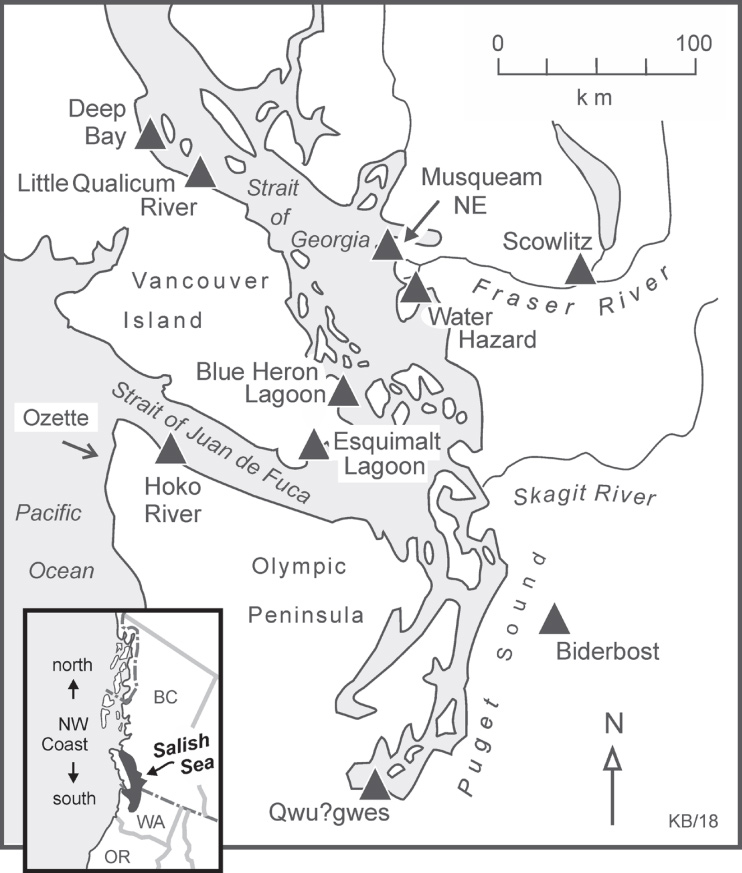
Self-armed, single piece, bentwood fishhooks like those from the Hoko River site have been recovered from other wet sites in the Salish Sea region (Figure 1). As the Curator of Archaeology at the Royal British Columbia Museum (RBCM) for the last 46 years, I have observed thousands of fishhook parts. The self-armed bentwood specimens are curious; it is not certain how this type of fishhook was used, whether individually or as part of multiple-hook devices. They have no ethnographic counterpart and appear to date previous to about 1,000 years ago. The Salish-Sea-style self-armed hooks are made by steam-bending a single narrow piece of wood with a knob carved at one end and a point at the opposite end. They do not show any evidence of having once had a separate barb. A different, much larger, self-armed hook that is also made of steam-bent wood, is found on the northern coast of British Columbia and when referring to that type, in comparisons, I use the term “Northern-style self-armed hook”.
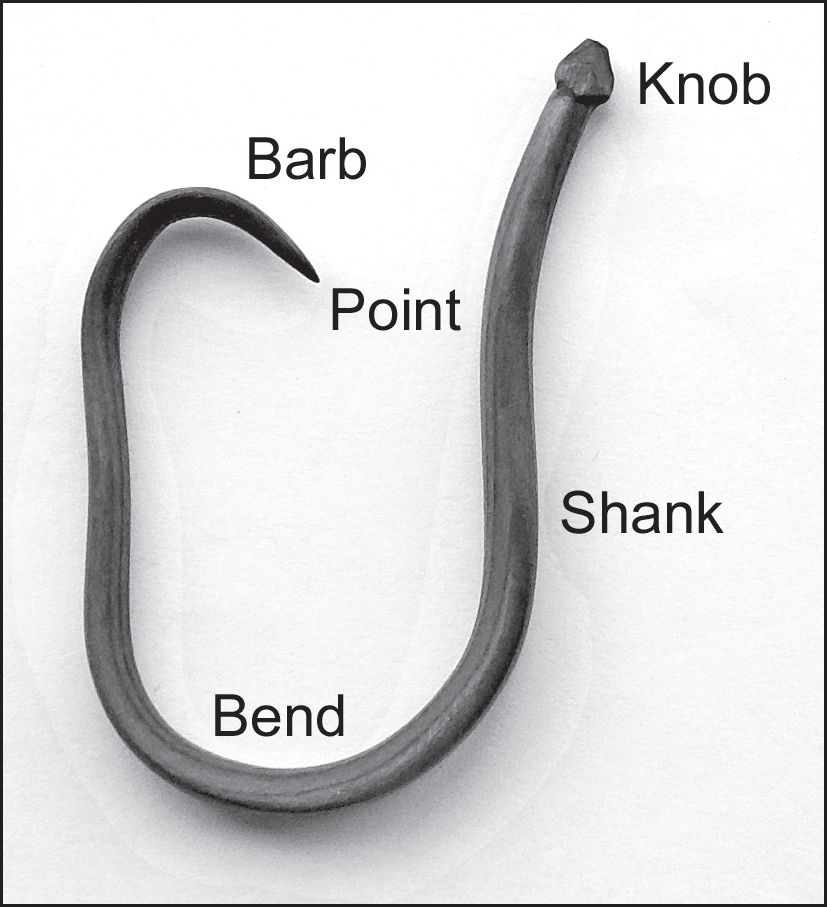
The shapes of the archaeological Salish-Sea style self-armed bentwood fishhooks have changed and do not reflect their original appearance. The image of the model hook made by Peter Grant (Figure 2) demonstrates the basic shape the hooks would have had at the time of their use. The image also indicates the terms used in this chapter for various parts of the hook.
This chapter presents information on self-armed bentwood hooks from sites in the Salish Sea region including some previously unpublished specimens. Most of the sites contain an abundance of fish remains, other faunal remains, and features and artifacts related to fishing technologies that incorporate self-armed hooks. The specimens provide a study sample for expanding our understanding of the distribution and use of this unique type of hook. To that end, I explore their relationship to ethnographic and archaeological specimens from British Columbia’s central and northern coast. Some conclusions are tentative and show the need for more thorough documentation of this and other types of wet site hooks.
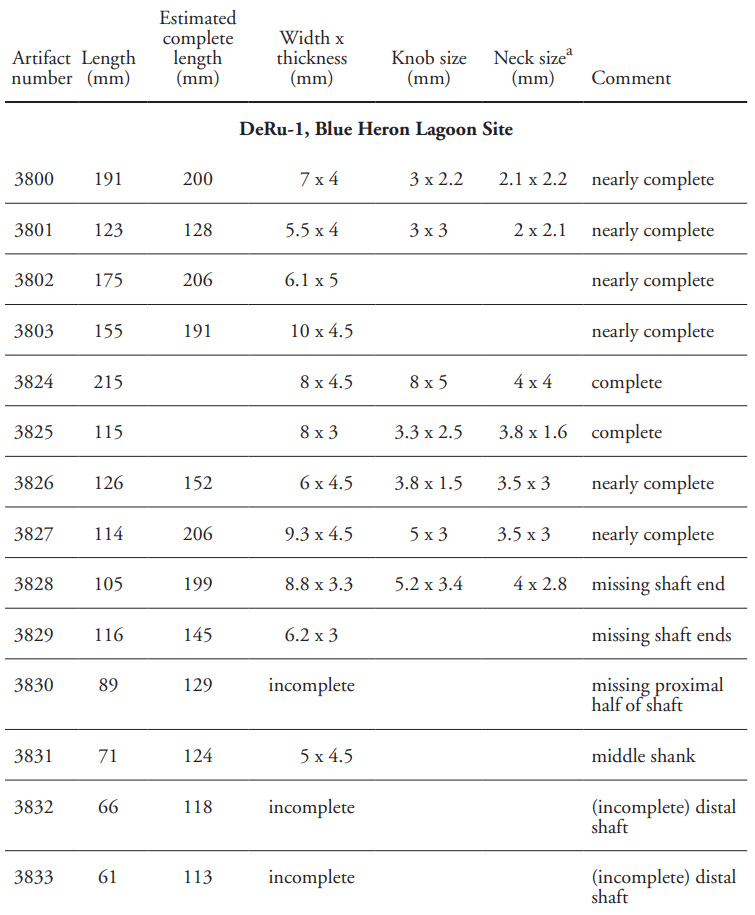
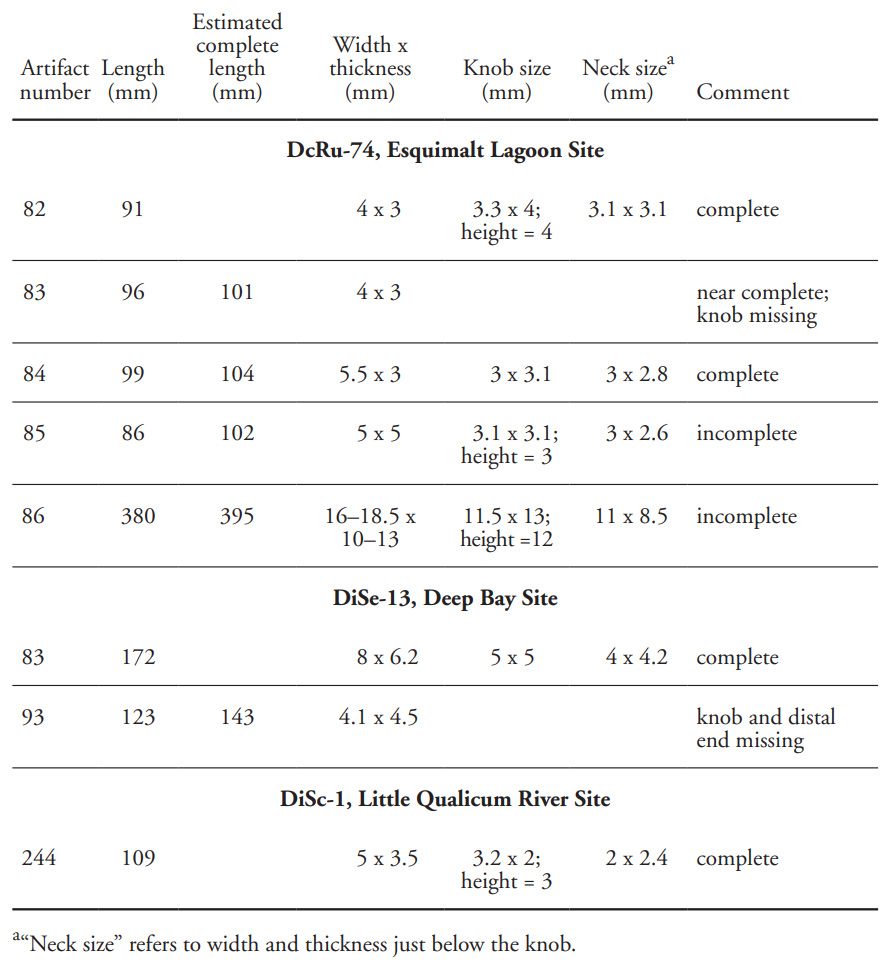

Self-Armed Salish Sea Fishhooks at the Royal British Columbia Museum
I analyzed and measured 22 self-armed fishhooks that are in the RBCM’s archaeology collections in 2015 (Table 1). The length of each hook was measured along the outer, or dorsal, surface from the tip of the barb point to the top of the knob. Where the specimen is not complete, I estimated the original length by matching the incomplete portion of a hook with the same portion on a more complete specimen of similar size. This allows for
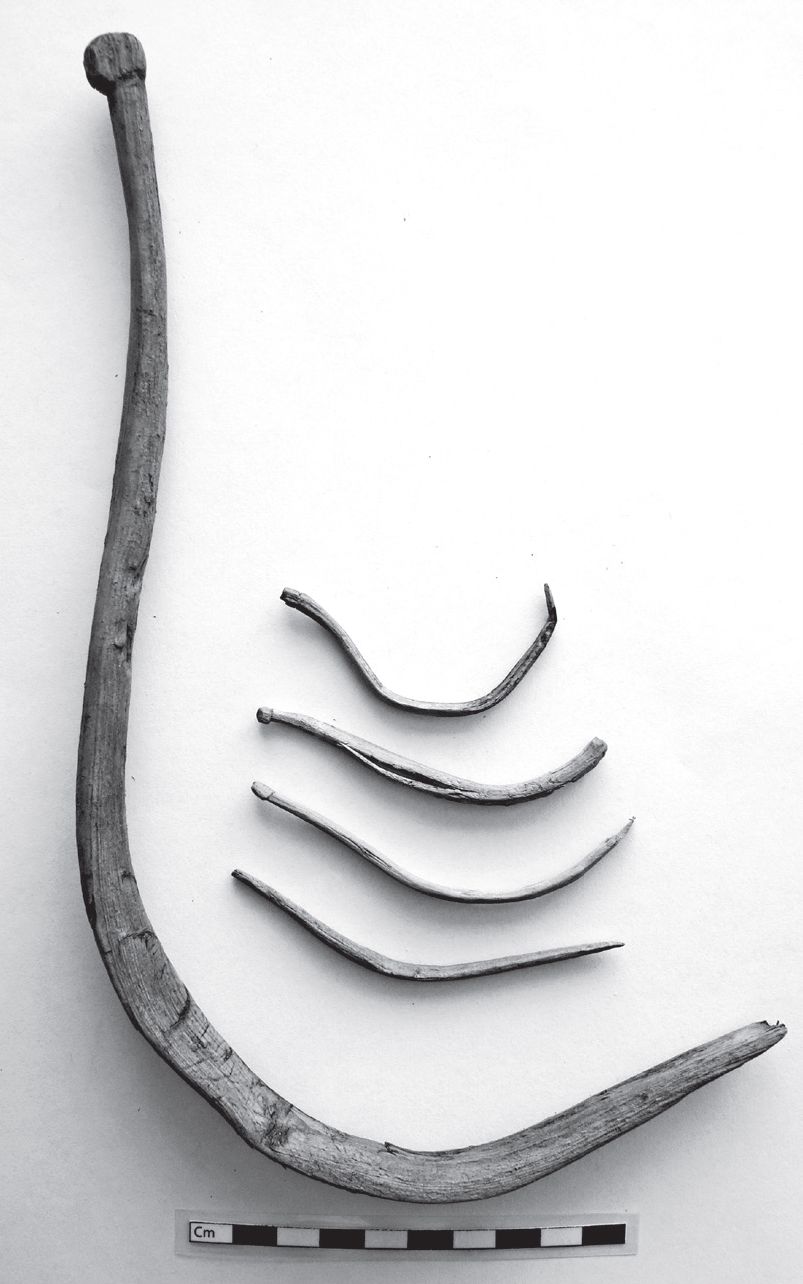
approximation of the size range for each site and thus increases accuracy of inter-site comparisons, as well as for establishing the existence of distinct groupings based on size. Width and thickness measurements were taken at the middle of the bend in the hook. Where knobs are present at the proximal ends of the hooks, their dimensions are given. The hooks are thinnest at the top of the neck below the knob and measurements are given for that location in Table 1.
DeRu-1, Blue Heron Lagoon Site
A private citizen, Peter Grant, recovered 14 self-armed bentwood hooks from DeRu-1, north of Sidney on the Saanich Peninsula of Vancouver Island. Eight are complete or nearly complete, and six are missing larger portions (Figure 3). The estimated original lengths of all 14 artifacts, if complete, would range from about 113 mm to 206 mm with a median of about 163 mm (Table 1). Radiocarbon dates from the lower deposits of the site provide a time range between 3980 cal BP and 3550 cal BP (Dady 2002). The hooks had been washed out of midden deposits and exposed on the beach at extreme low tide. The site has seen several archaeological excavation projects that did not recover wooden hooks. However, due to the enlarging of the inlet channel adjacent to the site, older, buried, underwater deposits were being exposed and washed out in the 1980s. These waterlogged deposits that contained the bentwood hooks have not been directly dated, but their stratigraphic sequence appears to fit into the early time sequence. If so, these would be the oldest self-armed bentwood fishhooks found to date.
DcRu-74, Esquimalt Lagoon Site
Excavations, in 2004, at Esquimalt Lagoon west of Victoria, revealed deeply buried midden deposits with four small and one large self-armed bentwood fishhooks (Figure 4), as well as numerous pieces of preserved wood, both worked and unworked (Eldridge 2008; Mathews and Dady 2004; also see Eldridge, this volume). If complete, the four small hooks would range from 91 mm to 104 mm in length, with a median of 100 mm. At 395 mm, the large hook (DcRu-74:86) is four times as long as the others (Table 1). The wood was not identified to species. The waterlogged deposits, near what was once a secondary entrance to the lagoon, appear to have been buried suddenly as the result of tectonically driven sea level changes or a large tsunami that occurred at this location around 3,000 years ago. All of the hooks were found in what the archaeologists who reported on the investigations define as “Locarno period” waterlogged deposits. These lowest deposits have a radiocarbon age of 2980 ± 70 cal BP (Mathews and Dady 2004).
DiSc-1, Little Qualicum River Site
A single self-armed bentwood fishhook, DiSc-1:244, was found with a wide variety of other waterlogged material at the mouth of the Little Qualicum River on the east coast of Vancouver Island (Figure 5). The wood was identified as true fir (Abies sp.) and the deposits date to about 1000 BP (Bernick 1983). I measured this hook according to the methods mentioned above and added 1 mm to the length from the published account (Table 1).
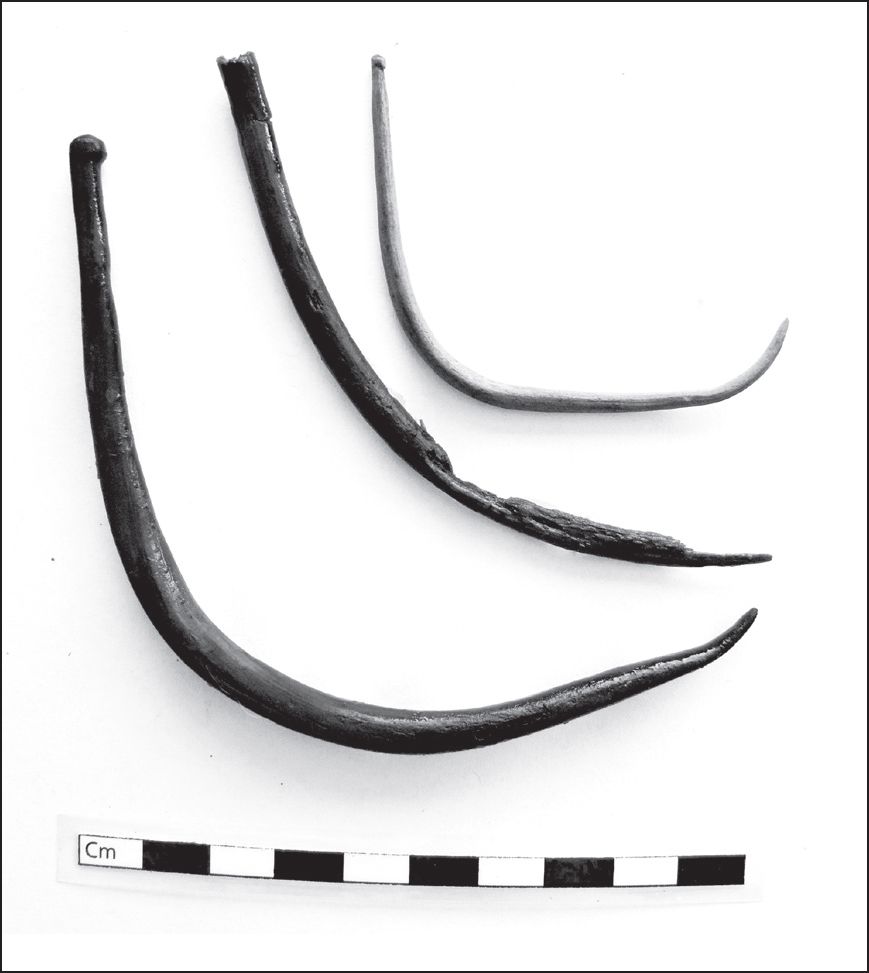
DiSe-13, Deep Bay Site
Two self-armed hooks, numbers DiSe-13:83 and DiSe-13:93 (Figure 5), were recovered during the monitoring and excavation of the Deep Bay archaeological site. The site is located on the east coast of Vancouver Island in Baynes Sound across from Denman Island. Only the complete specimen, artifact number 83, is noted as a hook in the archaeologists’ report; a second artifact, number 93, is incomplete and is not noted (Streeter and Bond 2007). The size range is 143 mm to 172 mm, with a median of 157 mm (Table 1). Both hooks were recovered from waterlogged deposits that extended from 1.75 m to 2.5 m below the surface. A combination of two charcoal samples provided a radiocarbon age of 2000—1730 cal BP for these deposits (Streeter and Bond 2007). A third radiocarbon date of 2040 ± 70 BP, on a shell was not corrected for the marine reservoir effect (see Stuiver et al. 1998). A correction of 630 years (calculated via http:// radiocarbon.pa.qub.ac.uk/marine) would date these deposits, which are above the wet-site area, to about 1410 BP.
Self-Armed Fishhooks in Other Collections
There are at least 122 hooks similar to the RBCM self-armed bentwood specimens in other repositories, recovered from four sites in the Salish Sea region. Plus there are two tentative examples from two other Salish Sea sites. The following descriptive information, presented by site, is taken from published and unpublished accounts.
DgRs-30, Water Hazard Site (Point Roberts Peninsula—Boundary Bay) Seven similar self-armed hooks, all identified as made from Douglas-fir (Pseudotsuga menziesii), are reported from the Water Hazard site in Tsaw- wassen, south of Vancouver, British Columbia. Four are complete and range in length from 160 mm to 300 mm. The cross sections vary in shape, being lenticular, triangular, and oval. Width at the bend averages 5.4 mm (range, 4—6.5 mm). Three radiocarbon dates on other waterlogged artifacts from the same deposit provide an average age of 1743 BP (Bernick 1989).
DhRt-4, Musqueam Northeast (Fraser River Delta)
Two incomplete self-armed hooks from the Musqueam Northeast site are housed at the University of British Columbia Laboratory of Archaeology. The slender hooks are carved with the tapered points aligned with the grain of the wood. Both are oval to circular in cross section with inward curved tips. Both are missing their proximal ends. The larger hook, 140 mm long, is missing the upper portion of the shank. It is 6 x 6 mm at the bend starting at 80 mm from the tip. The second hook consists of a 39-mm-long portion of the crook and the curved tip, measuring 4 x 3 mm at the broken end of the crook. The larger hook is made from western hemlock (Tsuga heterophylla) and the small hook portion is made of true-fir wood. The hooks are from waterlogged deposits dating to around 3000 BP (Archer and Bernick 1990; Borden and Archer 1975).
45SN100, Biderbost Site (Puget Sound)
At the Biderbost site on the Snoqualmie River in Washington, four self-armed hooks were recovered from waterlogged deposits. They are described as flattened on the outside while the inside surface is convex in cross section. Each has a turned up point on the end of the crook and a carved knob on the end of the shank. The method of measurement is not mentioned in the published description (Nordquist 1961), so the following dimensions should be considered as approximations for comparative purposes. The reported lengths range from 117 mm to 185 mm (median, 139 mm); the length-width-thickness measurements by artifact number are: No. 5 (117 x 7 x 4 mm), No. 101 (130 x 6 x 6 mm), No. 102 (185 x 6 x 4 mm), and No. 103 (127 x 4 x 4 mm). The wood is described as being hemlock but it appears this is based on ethnographic analogy rather than a professional identification (Nordquist 1961:10—12). The Biderbost specimens date to about 2000 BP (Nordquist 1976:10—12; Rorabaugh 2015:376).
45CA213, Hoko River Site (Olympic Peninsula—Strait of Juan de Fuca) Croes (1995:84—107) describes several types of wood fishhooks from the Hoko River site including 109 self-armed specimens, many of them broken. The self-armed hooks (his Type B) were thought to have been used to catch cod (Croes 1997:603—614). Croes does not specify how many were identified to species. Thirteen self-armed hooks are described as Sitka spruce (Picea sitchensis), one as Douglas fir, and one as western white pine (Pinus monticola) (Barbour 1980:158). The Hoko River wetsite deposits date to 3000—2500 BP (Croes 1995; Blinman 1980). Croes (1995:84—107) provides numerous illustrations, an analysis of breakage patterns, and descriptions of a two-strand leader line that would have been attached to the end of the shank below the knob. Hoff (1980:70) divides the hooks into three size-groups based on the dimensions of 37 specimens: 19 small hooks, 100—160 mm long; 17 medium size hooks, 180—280 mm long; and a single large hook, 320 mm long.
Possible Additional Specimens
There are two other hooks from the Salish Sea that tentatively can be considered as self-armed hooks. One of these is from the Scowlitz wet site, DhRl- 16, on the Harrison River near its confluence with the Fraser River (Bernick 1994:36; Lepofsky et al. 2000) and the other is from the Qwu?gwes site, 45TN396, in southern Puget Sound (Croes ed. 2013). Each site yielded a single broken example. If they were self-armed hooks, they would fall in the small size-group as defined by Hoff (1980) for the Hoko River hook sample.
Bernick (1994) reports that the Scowlitz artifact was from waterlogged deposits that provided post-Marpole-period dates. These have an age range of 1070 cal BP to 680 cal BP (Lepofsky et al. 2000). The placement of the fishhook in this sequence is uncertain. Bernick (1994:36) suggests that the incomplete specimen could be the proximal portion of a selfarmed bentwood hook or part of a composite hook with a separate barb. She describes the artifact, DhRl-16W:8, as having a carved knob at the proximal end and an incomplete shaft with a length of 124.5 mm. It is made from western white pine wood. The semi-circular cross section is 7 x 4.5 mm at its widest point.
The Qwu?gwes site possible-self-armed hook, made of western hemlock, is 133 mm long and 6.8 x 4.9 mm at the bend. The knob end and the tip of the crooked point are absent making it difficult to identify as a self-armed hook. This site dates from 750—310 cal BP (Croes ed. 2013:90-92, 516; Croes and Hawes 2013:128).
Regional Comparisons
There are 144 hooks from eight archaeological sites under consideration here, with the possibility of two more from two other sites (Scowltiz and Qwu?gwes). Unfortunately there is no uniformity in the information available on all the examples. The wood has not been identified to species for all specimens, and several reported descriptions do not indicate how the measurements of the hooks were taken. Small sample sizes and inconsistent radiocarbon date reporting further limit inter-site comparisons.
Most of the self-armed hooks from the Salish Sea region described in this chapter date in the 3000-1730 BP age range (Table 2); the single hook from the Little Qualicum River site, DiSc-1, found in deposits dating to around 1000 BP, is an exception. The incomplete specimens from the Scowlitz and Qwu?gwes sites are also younger than the majority but it is not certain that they are self-armed hooks.
The Hoko River site on the Olympic Peninsula, Washington, exceeds all the others with a sample of 109 self-armed hooks (complete and broken), in addition to many composite separate-barb hooks. Whereas the Hoko River site accounts for 75.7 percent of the known self-armed hooks, only 6.2 percent (nine) have been found in the lower Fraser River region—at the Musqueam Northeast and Water Hazard sites. Four examples (2.8 percent) are from one site, Biderbost, in Puget Sound, and 22 (15.3 percent) are from sites on Vancouver Island—Blue Heron Lagoon, Esquimalt Lagoon, Little Qualicum River, and Deep Bay. It is likely that the large number of self-armed hooks from the Hoko River site is a result of the extensive excavations undertaken there. More extensive excavations at the other sites would likely have produced much larger samples of wooden hooks.
Inter-site comparison of self-armed hook sizes is difficult to interpret as the size ranges of the existing hooks may be related to the number of available specimens and reflect different size clusters than what might be revealed with larger samples. Altogether, the self-armed hooks range in length from 91 mm to 395 mm. This range is represented at a single site, DcRu-74, and at both ends of the range extends beyond that reported for the Hoko River site. Hooks from the other sites fall in between, with an overall trend toward the shorter end of the range. Only the large, 395-mm-long, hook from DcRu-74 and the large specimen of from the Hoko River site, 320 mm long, are comparable in size to the Northernstyle self-armed hooks (discussed in the next section).
It is interesting that self-armed hooks like those found in the Salish Sea have not been described as occurring among the vast number of wooden artifacts from Ozette. The Ozette site is located outside the Salish Sea region discussed here, but geographically close by and the subject of many studies on wooden artifacts. I have not examined the Ozette material. Croes (1997) notes that the Ozette assemblage includes a large number of composite separate-barb hooks with bone barbs (his Type C). Most reported examples of these Ozette composite separate-barb hooks are the size of the two rare, large, self-armed hooks from the Salish Sea. Friedman (2005:168—178) describes 285 complete and incomplete “halibut hooks” for the Ozette site. These are composite separate-barb hooks with either bone or wood barbs and most are 300 mm long and 10 mm in width at the bend in the shaft. A lesser number of smaller composite, separate-barb hooks from Ozette average around 100—115 mm long and 5 mm wide (Friedman 2005), which matches the smaller self-armed hooks described in this chapter in respect to length, but the small Ozette composite separate-barb hooks tend to be wider.
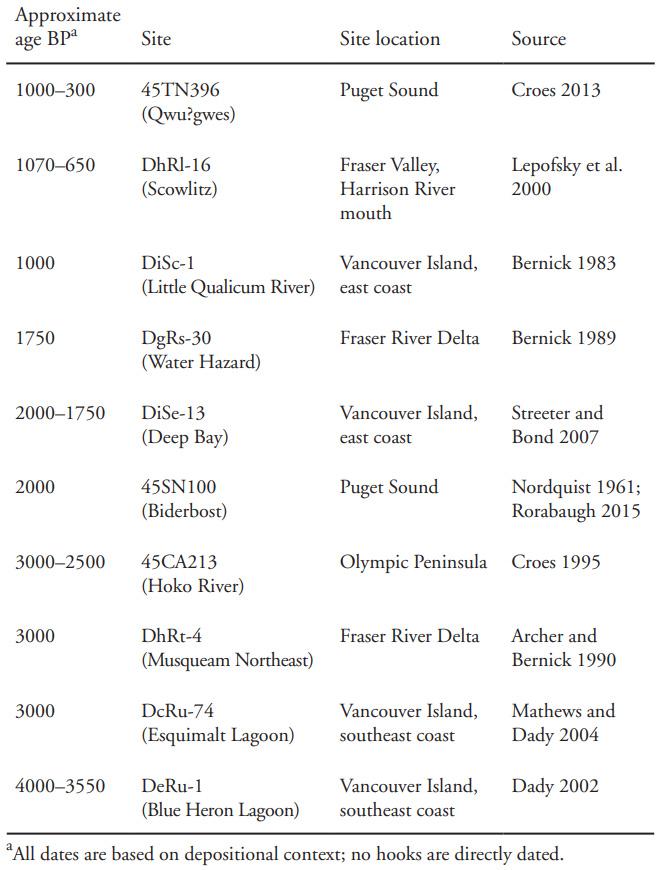
Raw material, that is, wood species, is another attribute of potential inter-site comparative interest. All identified self-armed hook specimens from the Salish Sea region are made from coniferous wood. However, most have not been professionally identified, making it difficult to evaluate similarities or differences.
In his ethnographic study of Coast Salish fishing, Suttles (1974:115) indicates that composite separate-barbed halibut hooks were made from steamed fir, hemlock, or yew. Examples of this type of hook from the outer coast site of Ozette include 115 specimens of hemlock and 73 of Douglas-fir, as well as 4 of Sitka spruce (Friedman 2005). The identified Salish Sea self-armed hooks are also made from these species, including Sitka spruce, but none are identified as made of yew. Friedman’s discussion of the functional use of wood types is relevant to the species documented here, as she notes that they are the stiffest woods available in the region (Friedman 1976:44).
The Northern-Style Self-Armed Hook
Although there are no ethnographic analogues for self-armed hooks in the Salish Sea region, there are both archaeological and ethnographic examples of a Northern-style self-armed fishhook from farther north along the coast (see Figure 6). Hobler (1978) reports numerous Northern-style self-armed hooks from the Axeti wet site in Kwatna Inlet, located west of Bella Coola on the central coast of British Columbia. They were recovered from deposits with radiocarbon dates of 240 ± 80 BP, 450 ± 90 BP, and 1280 ± 100 BP. Hobler indicates that in general size and ruggedness the Axeti hooks seem larger than the older, self-armed hooks from the Salish Sea sites, and that they are smaller in diameter and shorter in length than Northern-style hooks he had found in a cache on Haida Gwaii (Hobler 1978). Croes (1995, 1997, 2003) has hypothesized that the Salish-Sea-style self-armed hook that he defines as Type B has survived in this Northern-style form.
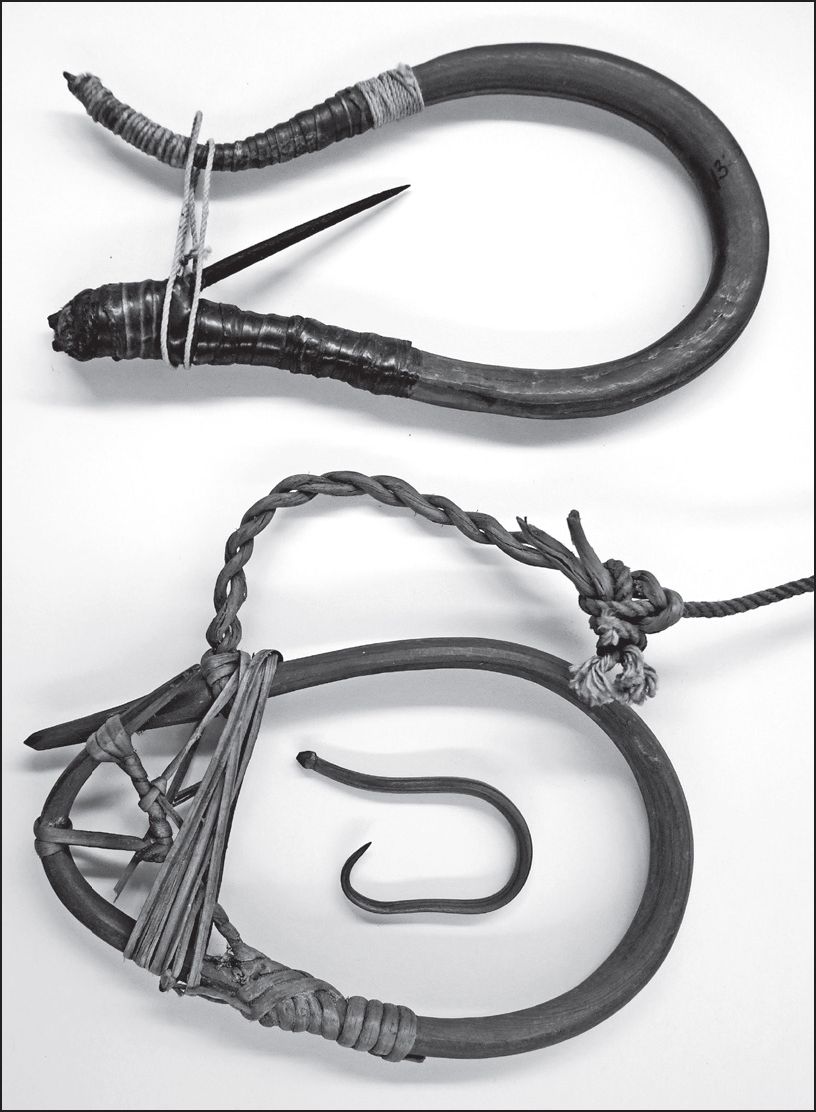
To evaluate Croes’ hypothesis, I compared characteristics of the Northern-style self-armed hook with the Salish Sea self-armed specimens. In regard to size, the Northern-style self-armed hooks are much thicker than the usually very thin, self-armed hooks of the Salish Sea. None of the Salish Sea self-armed hooks have been found with remnants of a wrapping, such as that on the Haida Northern-style self-armed specimens to hold the hook closed, or with the small wooden peg used to hold the hook open (Figure 6).
The Northern-style self-armed type is best known ethnographically among the Haida for catching the sablefish (Anoplopoma fimbria), referred to locally as black cod or skil fish—the latter being the anglicized Haida name. Sablefish are found in muddy sea beds in the North Pacific at depths of 300 m to over 2,000 m (Eschmeyer et al. 1983). Northern-style self-armed hooks were described by Hudson’s Bay Company factor Alexander Mackenzie, who lived on Haida Gwaii in the 1870s and preserved sablefish for his own use (Anderson 1883). Mackenzie (1892) noted the Haida name for this type of hook is Skyll-tow. He collected a specimen
made of a spruce knot steamed into form.. .used for catching the skill or black cod; a fish which inhabits very deep water, being sometimes hooked at the depth of 200 fathoms. When the hook is baited, it required to be set by springing it open and keeping it in that position by means of a small wooden pin about three inches long. When the fish is hooked it pushes the pin out, and the strain on the hook being released it closes on the fish’s jaw and thus effectively prevents its riddling [sic] itself off the barb and escaping. (Mackenzie 1892:56—57)
A more comprehensive description has been provided by Washington state fish commissioner and amateur anthropologist James Swan (1883, 1884). What is significant in Swan’s description is that these hooks are part of complex multiple hook devices. During an 1883 visit to Haida Gwaii, he learned that the Haida used a kelp line
prepared like the kelp lines of the Makah Indians of Cape Flattery, and the natives of the west coast of Vancouver Island. These lines are in pieces of fifteen or twenty fathoms each, and are knotted together so as to form one line one hundred fathoms long, for the black cod are only found in deep water of 60 to 80 fathoms.
The hooks are made from the butts of limbs of hemlock, cut from the heart of old logs. These are split into small pieces, then cut or whittled into suitable shape, then steamed and bent into a form which resembles the longitudinal section of a goose egg. The lower arm of this egg shaped implement is turned back so as to form a hook, and to this lower arm the bait is securely fastened by a lashing of twine sinew. This line is attached at the end. The two ends of the hook when not in use press strongly together, but when baited they are kept separate by a short stick which the fish knocks out when he bites the hook and the two parts closing together hold him fast by the jaw. From eighty to 100 of these hooks are fastened to the line, two feet apart and when ready for use are sunk to the bottom by an ingenious contrivance for a sinker, which is free from the line when it is pulled up. This sinker is a stone, weighing 10 or 12 pounds. A small kelp line is wound around this and held by a loop or bight tucked under the turns, and the end made fast to the end of the larger one which is then wound around the larger stone sinker, and a small stone, which serves to bind it fast, and as a sort of tripping stone. The line is then lowered to the bottom and when about to be pulled up, the fisherman gives it a sudden jerk which pulls out the loop, loosens the small stone which falls out and this slackens the line around the large stone which also falls out and the line is relieved of its weight. The line is only down a few minutes, and so plentiful are the black cod that very frequently seventy fish will be taken at one haul. (Swan 1883:3)
Anthropologist Philip Drucker lists “bent circular cod hook” as element number 68 in his Northwest Coast cultural trait lists. He notes, “This was a type of hook similar to the U-shaped hook but lacking the bone barb. The lower end of the shaft itself was bent over to form the point and lashed in place with spruce-root splints. This type was probably more widely distributed than the lists indicate; modern iron hooks are made in this form” (Drucker 1950:169). This type of Northern-style self-armed hook was also used by the Xaisla of the northern coast of British Columbia and the Sayakwan Tlingit of southeast Alaska (Drucker 1950:169, 238-239).
In addition to a search for comparative information in published sources, I measured 37 Northern-style self-armed Haida “black cod hooks” in the RBCM ethnology collection. All 37 hooks were collected at Skidegate, Haida Gwaii, in 1911 by Charles Newcombe. Twenty-five of these are in two distinct bundles of 11 (size range, 410-470 mm) and 14 (size range, 330-460 mm) and had belonged to a single individual. The other 12 had a size range of 410-490 mm. The overall range of the lengths of the 37 hooks is 330-490 mm. These are all much wider and thicker in the bend than the Salish Sea self-armed hooks, ranging from 20 x 8 mm to 13 x 7 mm. It is clear that the Northern-style self-armed hooks are much more robust than the Salish Sea archaeological self-armed specimens and in that respect very different.
For further comparison, I examined the difference between the RBCM Northern-style self-armed ethnographic hooks and a cache of 70 similarstyle fishhooks as reported by Hobler (1978). The latter were found in a small rockshelter on the north side of Tasu Sound on the west coast of Moresby Island, Haida Gwaii. Hobler suggests a late precontact date for the assemblage. Although one composite hook had an iron barb, there were no other associated artifacts of clearly European manufacture. The other 69 specimens are complete or fragments of Northern-style selfarmed hooks. Hobler divides these into two types, 46 consisting of single pieces of wood and 20 composite hooks. The latter are considered to be composite not because they have a separate barb (which they do not), but due to their having a two-piece shaft with the tip section attached to the main shaft by a lashed scarfed joint. Both of these Northern-style self-armed hook types are similar in basic form and there is no reason to suggest they did not have a similar function.
Hobler reports that the average thickness of both types is 11.5 mm (standard deviation, 1.4 mm), the mean length of 32 of the single-piece hooks is 392 mm, and that the 10 two-piece-shaft hooks without tip ends have a mean length of 321 mm (Hobler 1978). If the latter were complete artifacts, they would overlap with the length range of the single-piece specimens.
In comparing the RBCM Northern-style self-armed ethnology hooks and the Tasu Sound archaeological cache of Haida hooks, there are some notable differences in size. The range of thickness of the Tasu Sound hooks falls just below the lower range of the RBCM ethnology hooks. In other words, the cache hooks are slimmer than the museum specimens. The length of the Tasu hooks is on the lower range of the RBCM ethnology examples. The Tasu Sound examples, presented by Hobler (1978), are close to the size range of the separate cluster of 14 hooks in the RBCM ethnology collection but smaller than the second cluster of 11 hooks that had been owned by the same person. They are also smaller than the other 12 RBCM Northern-style self-armed ethnology hooks that were not part of any cluster. All of these Northern style hooks are substantially more robust than the Salish Sea specimens.
What Species of Fish Were Caught With the Salish Sea Hooks?
Given the ethnographic and ethnohistoric accounts and what seems obvious, small hooks would be used to catch small fishes. However, hook size also reflects the age/weight of the fish and depth of capture. For example, the same hook may be used to catch an adult of a small species or a juvenile of a different species. Fish such as mature lingcod (Ophiodon elongatus) and Pacific cod (Gadus marcocephalus) would likely be too large to take with the small Salish Sea hooks. Lingcod reach much larger weights than Pacific cod and are more in line with the weight range of northern sablefish. They differ from the latter in being caught in much shallower waters.
The small thin hooks from the Salish Sea region must have been used for catching fish under about 3.6 kg (8 lbs.) or small bait fish. These selfarmed fishhooks of the Salish Sea region are different from the common U-shaped wooden hooks with bone points described in the ethnographic literature as being used for halibut and cod (Barnett 1939:230, 1955:85; Gunther 1927:202; Suttles 1974:115).
Boas (1909:471) indicates that hooks used for codfish on northern Vancouver Island are smaller than those used for halibut, but he does not specify their sizes. His example of cod hooks includes a single line with 17 hooks attached at distances of about 40 cm. He notes that ducks are sometimes caught with this kind of hook and that kelpfish are caught with a very small hook of the same kind as the others.
The best clues about which fish may have been caught with the self-armed hooks in the Salish Sea region are the fish remains found in association with them. But faunal preservation is poor at some of the sites (e.g., Biderbost and Scowlitz) or the provenience of the faunal material is difficult to associate with the deposits that contained the waterlogged wooden fishhooks (e.g., Water Hazard).
Nordquist (1961) suggests use of the Biderbost self-armed hooks to troll for river trout or salmon. This might be true for trout, but not likely to be the case for the larger salmon. At the Hoko River site, where the largest number of self-armed hooks have been found, 45 percent of fish bones were flatfish (Pacific halibut, petrale sole, English sole, and starry flounder). Rockfish comprised 9 percent, Pacific cod 20 percent, and lingcod 20 percent (Croes and Hackenberger 1988:62). As previously mentioned, Croes (1997:603—605) suggests that his Type B self-armed hooks were used to catch cod at Hoko. Of the fish identified at Hoko, we might suggest that the small sole, flounder, and rockfish, based on their size, also are fishes likely to have been caught with the small hooks.
Archaeological evidence of fish associated with other sites in the Salish Sea region where self-armed fishhooks have been found suggests that the potential species taken on these small hooks would include herring (Clupea pallasi); northern anchovy (Engraulis mordax); small, immature salmon (Oncorhynchus spp.); small rockfish (Sebastes spp.); sand lance (Ammodytes hexapterus); striped sea perch (Embiotoca lateralis); greenling (Hexagram- mos spp.); buffalo sculpin (Enophrys bison); red Irish lord (Hemilepidotus hemilepidotus); great sculpin (Myoxocephalus polyacanthocephalus); and ratfish (Hydrolagus colliei). Precisely which species of fish were caught with the Salish Sea hooks is difficult to conclude from the current sample and available documentation.
Differences Between Northern and Southern Self-Armed Fishhooks
Salish-Sea style self-armed hooks are not documented in the ethnographic literature or represented in museum ethnology collections. They are predominantly in site contexts dating to earlier than about 1750 BP. They are not like the more robust Northern-style self-armed hooks used for catching sablefish or like the large southern coast barbed hooks used for catching halibut. Croes hypothesized that a “Locarno/Marpole phase” self-armed hook was representative of an earlier economic stage on the southern coast and continued into historic times on the northern coast. The evidence gained from comparing characteristics of the northern and southern self-armed hooks does not support this hypothesis. The northern style self-armed hooks are substantially different from the Salish Sea wet-site specimens.
It is uncertain if the absence of the self-armed Salish Sea hooks in the large Ozette assemblage is a reflection of the relatively recent age of Ozette. That is, they simply were not in use at the time the site was occupied. Alternatively, their absence may reflect the fact that Ozette is not in the protected waters of the Salish Sea and fishing strategies or target prey were different.
Future research needs to focus on trying to draw close associations between well dated types of fishhooks, fish habitats, and the species of fish remains found in the archaeological sites. Further experimentation in fishing with replicated hooks should help define the weight limits of fish caught by various sizes of hooks and narrow the range of possible fish species that they could catch. We also need to explore why the selfarmed hooks fell out of use in the Salish Sea region. Were they replaced by a new kind of technology, such as a particular type of fish trap? Or by changes in fish species harvested?